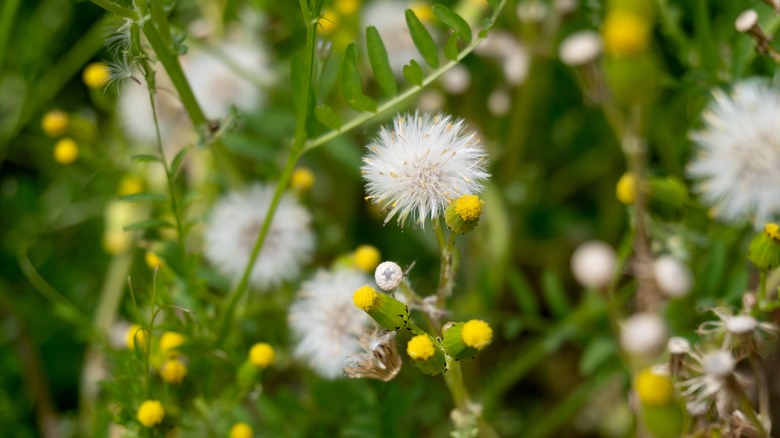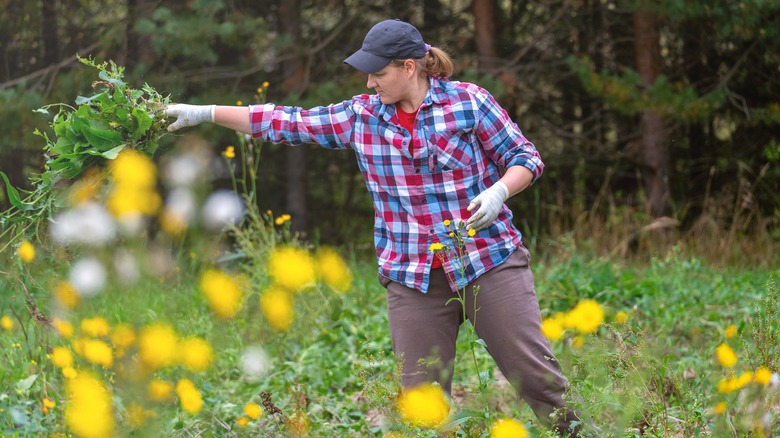Herbicide Is Not The Only Way To Get Rid Of Common Groundsel Weeds In Your Lawn
Having a weed free, lush green lawn is the ultimate dream. The only thing standing in your way may be common groundsel (Senecio vulgaris) weeds. These pesky weeds are from the sunflower family and look like dandelions that haven't fully opened. Since they can produce up to a million seeds in one season, getting rid of them completely isn't as easy or fast as you might think. But before you pull out your handy-dandy herbicide and get to spraying, there are other efficient and less-harmful techniques you should try first. You can remove common groundsel weeds from your yard by digging them up, cutting them down, and keeping your lawn thick with grass and other plants.
Common groundsel can grow 4 to 18 inches tall and is found all over the world. In America, you'll mostly find it west of the Cascades where there are more damp and mild winters. Unfortunately, this ideal climate means they sometimes flower year round and may produce multiple generations in a year. It can be identified by its deeply-lobed leaves that can be smooth or hairy and small yellow flowers. This adaptable weed doesn't rely on pollination to produce seeds but is self-fertile instead. It's also toxic to humans and animals, containing pyrrolizidine alkaloids that can be detrimental to your health. Due to its adaptive, toxic, and invasive nature, you should remove common groundsel as soon as possible.
The safest ways to remove common groundsel weeds
There are several ways to go about preventing, controlling, and removing common groundsel weeds from your lawn. It's important to note that groundsel seeds spread easily through wind, clothes, equipment, contaminated crop seed, and contaminated manure used for fertilizer. However, you can cultivate the ground before the seeds form to effectively control the weeds. Cultivation means disturbing the soil using a tool like a hoe, harrow, rake, or shovel. You can do this when weeds first sprout to upheave them and prevent them from taking root.
The size and intensity of the invasion will determine the type of tool you need to get rid of weeds. If you're dealing with full grown groundsel weeds, you'll want to pull them out, dig them up, or cut off the flowers before they seed. However, they can still produce more flowers if you only cut or mow them, so it's best to remove the plant entirely. You'll also need to cultivate and cut the plant down multiple times to keep it from continuing to grow back. And don't dispose of the plucked groundsel weed in your compost. It's best to completely remove them from the area. Using fertilizer when necessary will help keep your lawn thick and may effectively prevent the growth of common groundsel as well. Dense cover crops can also keep this weed from growing.
Use herbicide last, if at all
Many people use herbicides in the United States, and most residential herbicide use happens without any training, certifications, or regulations, which can lead to possible misuse. There is definitely a right way to use herbicide, but it comes with serious downsides and often doesn't live up to expectations. Even if you follow the herbicide application directions, it can still run off into lakes and streams, damaging the habitats of water animals and contaminating drinking water. Additionally, lawn herbicides can unintentionally kill other plants and harm beneficial insects, completely disrupting the food chain. Not to mention that you can absorb certain herbicide chemicals through your skin or inhale them, and you may put your pets at risk as well, especially if you don't use them correctly. It's important that you only rely on herbicides as a last resort, use them sparingly, and follow the directions on the label.
The best way to control common groundsel is through mechanical and cultural practices. If you do need herbicide, you can use anything with glyphosate or diquat in it to get rid of more established and stubborn common groundsel weeds — but keep all the cautions about herbicides in mind. You can also try making your own DIY weed killer with a vinegar mixture. Overall, it's best to use the least harmful ways to kill weeds in your lawn.


